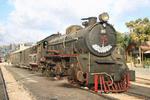 Jordan_24_9_2008_1.jpg (149669 bytes)
Jordan_24_9_2008_1.jpg (149669 bytes)|
The Railfaneurope.net Picture Gallery
Directory: /pix/ne/Jordan/steam/85
Last update: Sun Nov 16 05:48:42 CET 2014
|
| Jordan 24.9.2008: After three days of visiting tourist sites like Petra and Wadi Rum, the tour group returned to Amman station for the journey north to Dera’a, in Syria. The group’s train was hauled by Pacific No. 85 (Nippon 1953, but builders’ plates say 1959, the year of delivery to Jordan). The train consisted of a bogie van for the group’s luggage, an old Hedjaz coach and two air-conditioned coaches, built new on former bogie wagon frames for the short-lived Aqaba – Wadi Rum steam service. Roger Griffiths; roger.griffiths@hotmail.com |
| Jordan 24.9.2008: The next stop after Samra was Mafraq, where a lengthy stop ensued while arrangements were completed for the crossing from Jordan into Syria. Shortly after Mafraq station came the last chance for a run-past on a very steep and curving section of track, before all cameras had to be put away for the journey through the sensitive border areas of Jordan and Syria. Here 4-6-2 No. 85 (Nippon/1953) makes her assault on the sharp gradient. Roger Griffiths; roger.griffiths@hotmail.com |
| Jordan 24.9.2008: Pacific No. 85 (Nippon/1953), triumphantly tops the gradient and leans into the sharp curve – next stop: Dera’a, Syria! Roger Griffiths; roger.griffiths@hotmail.com |
| Jordan 24.9.2008: The cabside plates carried by 4-6-2 No. 85 (Nippon 1953), specially made for the Aqaba – Wadi Rum service. Sadly that train ran – very rarely – for only a couple of years, for two reasons. (1) Visitors to Aqaba primarily want sun, sea and sand, and not a steam train ride to Wadi Rum that took hours, compared to the much shorter time by air-conditioned road vehicles. (2) The Aqaba – Wadi Rum line was built in 1975 to move huge quantities of potash to Aqaba docks. As such it is heavily trafficked and because it is CTC-signalled, any steam specials ran for enthusiasts could not do what enthusiasts want – frequent stops, reverses and run-bys on what is a very dramatic and hilly railway. The result was little patronage and an operational headache for the potash railway’s management – hence the steam service’s withdrawal. Roger Griffiths; roger.griffiths@hotmail.com |
| Jordan 24.9.2008: Pacific No. 85 (Nippon 1953) makes a smoky northbound departure from Amman, passing a well-preserved hand crane of 1903 vintage. Roger Griffiths; roger.griffiths@hotmail.com |
| Jordan 24.9.2008: Shortly after leaving Amman station, the Hedjaz Railway passes through a curving valley that has, on one side, so far escaped from the city’s urban sprawl. With many birds of prey circling in the distance, Pacific No. 85 (Nippon/1953) brings its train past some ramshackle-looking livestock pens. Roger Griffiths; roger.griffiths@hotmail.com |
| Jordan 24.9.2008: After transiting the amazingly little developed valley, the train re-entered Amman’s built-up area, with the line twisting and turning continuously, twice crossing sharply curved viaducts, as seen here. We are 7.5 miles (12kms) from Amman station, but still well within the city boundary. Roger Griffiths; roger.griffiths@hotmail.com |
| Jordan 24.9.2008: A first servicing stop at Zerka, where Jordan Railways’ only driver qualified to drive steam locomotives – Mr Gassan S’aed - oils round, while his fireman deals with the watering of Pacific No. 85 (Nippon/1953) Roger Griffiths; roger.griffiths@hotmail.com |
| Jordan 24.9.2008: Leaving Zerka the train was escorted by several 4-wheel drive vehicles full of very senior police officers. Their purpose was to successfully halt traffic at a large roundabout, where four, major dual-carriageway roads intersected. Why? Because the railway literally cuts through the centre of the roundabout! Sadly, but quite understandably, we were not allowed to arrange a run-past there! Not long after that the built-up are disappeared to be replaced by many square kilometres of well-tended land where much produce was being grown. In the centre of that area was this 10-arch viaduct, being crossed by 4-6-2 No. 85 (Nippon/1953); note the many irrigation pipes scattered about. Roger Griffiths; roger.griffiths@hotmail.com |